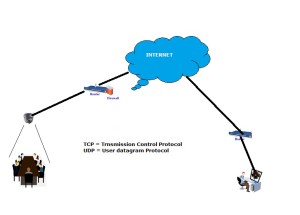Remote View Setup in a CCTV System
In recent years, it has become increasingly popular to set up your CCTV cameras in a way that enables you to view images remotely via desktops or your mobile phone. This is hugely beneficial for anyone interested in purchasing an affordable CCTV system from a high street store, as it offers the ability of being able to see your property when you’re away from home. Having this kind of accessibility in the palm of your hand is incredibly efficient, and has been made even more so thanks to the improvements in both 3G and 4G connections.
This article will focus on the technical side of configuring your CCTV system to allow remote access through a handheld or desktop device, with particular emphasis on protocol, TCP and UDP.
What is Protocol?
To put it simply, protocol is a set of rules used in data communication via a common medium. This is similar to the way that an international language is used during overseas trades as a way to ensure that all parties understand the language. Most commonly, languages used for this type of interaction are English and French, as these are languages that a large portion of people can speak and interpret with ease.
Protocol plays the same role in networking, and is used to communicate across the network boundaries from one computer to another via a common platform – the internet.
TCP & UDP
When data is sent over the internet, it is transmitted in data packets, and will include both the sender’s and recipient’s IP addresses. This means that receipt of the data can be tracked easily. However, the order in which the data is sent is not always the order in which it is received, meaning that it needs to be put back in order before it can be read by the receiving computer. This is done by Transmission Control Protocol (TCP). Both TCP and UCP (User Datagram Protocol) run on top of the common protocol IP (Internet Protocol). Where TCP is a connection-oriented protocol, which requests acknowledgement for data packets sent, UDP does not require the server to provide this.
TCP & UDP in CCTV Application
In CCTV applications, TCP is by far the most commonly used protocol. It is also the most reliable, as it can ensure that no data is lost thanks to the need to confirm receipt. If, for example, you are watching a football match online using UDP and lose connection, when it reconnects it will catch up with the live stream rather than starting at where you lost your connection.
If on the other hand you are using TCP, the datagram will be sent and acknowledgement will be required, meaning that the match will restart from where your connection was lost.
Because CCTV has to be high security and as reliable as possible, TCP is the best option for your remote setting. However, there may be some delay in transmission due to the high bandwidth required for this type of connection. If your internet is not high speed, you may suffer issues because of this.
In conclusion
To conclude, TCP is becoming more common for use in CCTV systems thanks to its reliability and security. If you’re not sure which your system uses, you have the option to open both TCP and UDP as server port.

